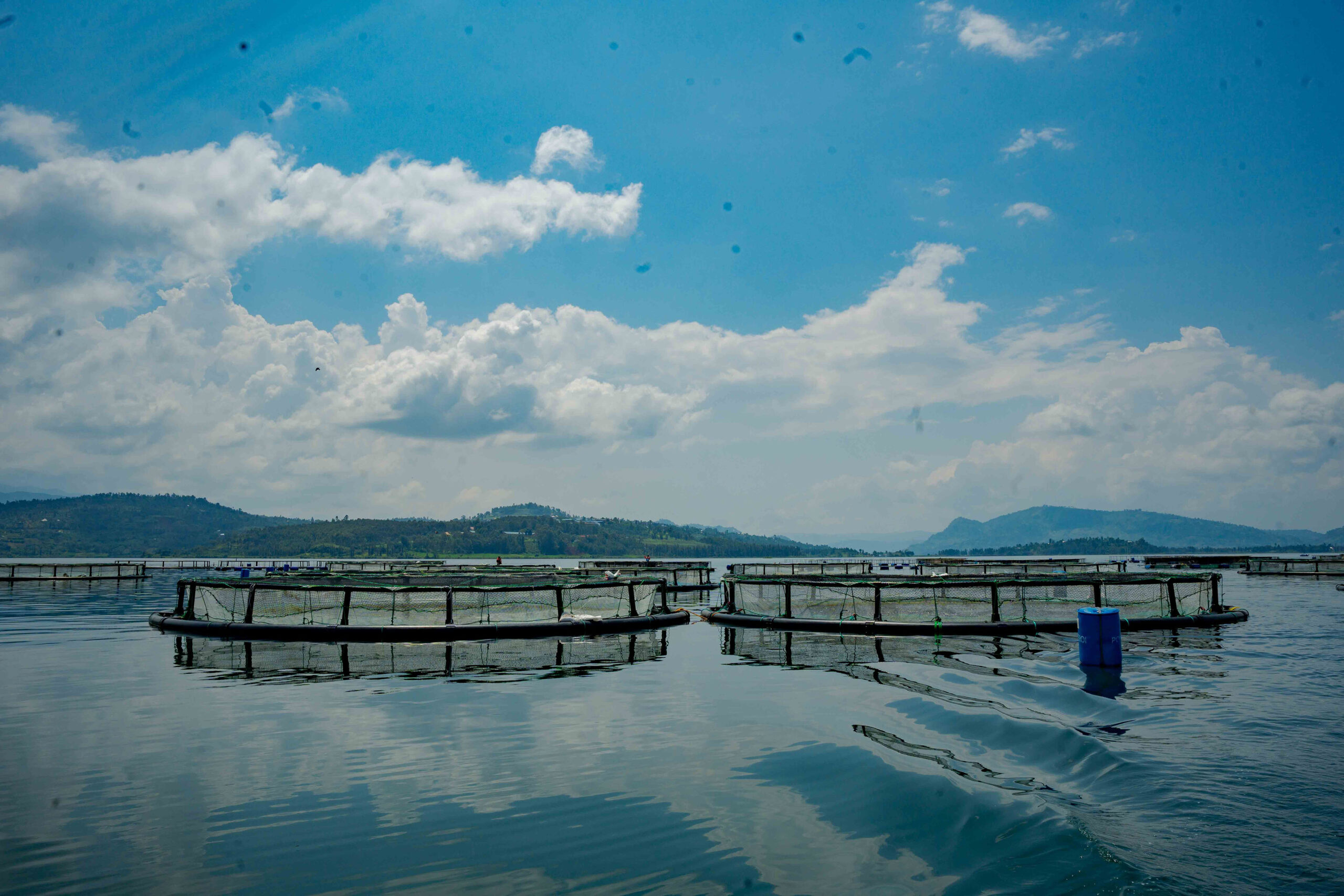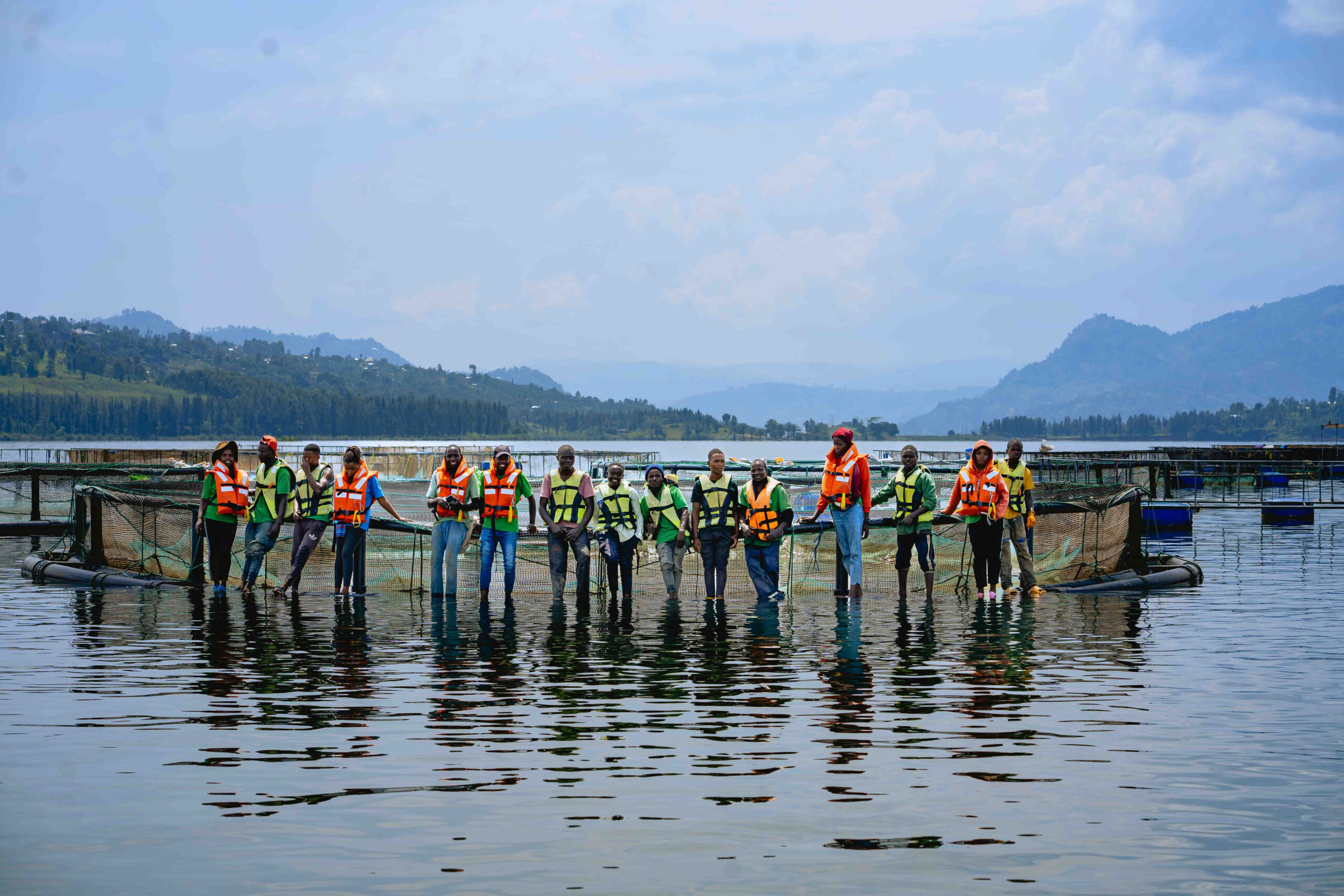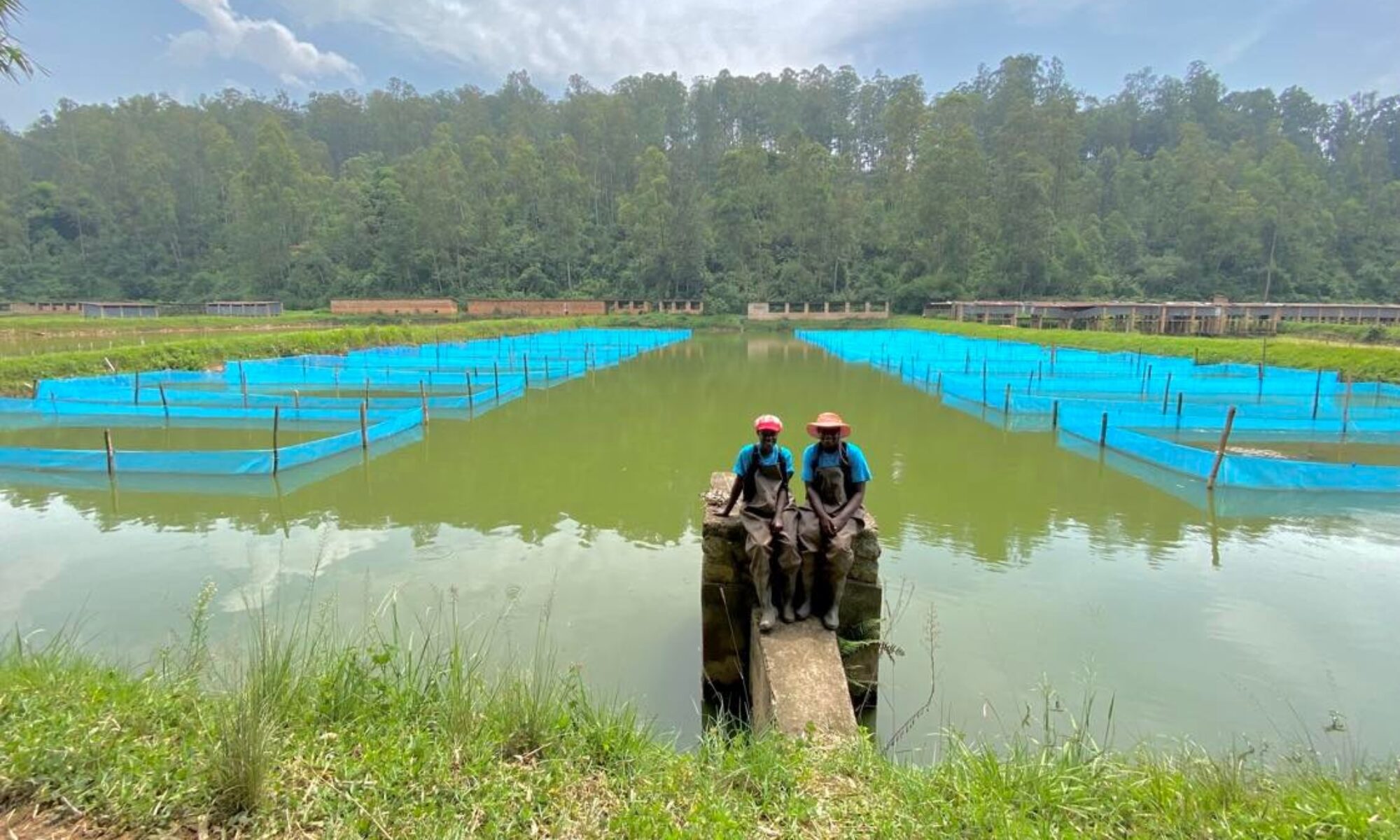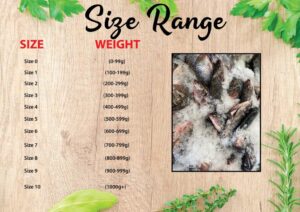April 2018
It is early morning in Sindo Beach, Homa Bay County in western Kenya. At the Victoria Farms, workers are seen clocking in for work then proceeding to their various planning meetings.
The fish farm has more than 200 employees comprising cleaners, cage managers, fish feeders, hatchery workers, and fishmongers. A flurry of activity ensues soon after the meetings breaks off.
Victory Farms is among success stories of cage aquaculture in sub-Saharan Africa. Other countries where it is practised include Uganda, South Africa and Ghana.
The fish firm was co-founded by Joseph Rehmann and Steve Moran.
How cage farming in Lake Victoria is boosting fish stocks
MONDAY APRIL 16 2018

Tilapia harvest from Victory Farm in Homa Bay County in Western Kenya. FILE PHOTO | NATION
Summary
- Victory Farms is one among the success stories of commercial cage aquaculture in sub-Saharan Africa.
- The fish farm has more than 100 deep-water cages located almost a kilometre or a 10-minute boat ride offshore.
- Last year, Victory Farms produced 300,000 units of fish with an average of 80,000 tonnes per month for the local market.
By ALLAN OLINGOMore by this Author
It is early morning in Sindo Beach, Homa Bay County in western Kenya. At the Victoria Farms, workers are seen clocking in for work then proceeding to their various planning meetings.
The fish farm has more than 200 employees comprising cleaners, cage managers, fish feeders, hatchery workers, and fishmongers. A flurry of activity ensues soon after the meetings breaks off.
Victory Farms is among success stories of cage aquaculture in sub-Saharan Africa. Other countries where it is practised include Uganda, South Africa and Ghana.
The fish firm was co-founded by Joseph Rehmann and Steve Moran.
In a sense, fate brought the two men together. Both Rehmann and Moran are passionate about aquaculture. They met in Ghana, West Africa many years ago and quickly became friends.
They would eventually cross over to East Africa and set up Victory Farms — which pioneered fish cage farming in Lake Victoria.
ADVERTISEMENT
How cage farming in Lake Victoria is boosting fish stocks
MONDAY APRIL 16 2018

Tilapia harvest from Victory Farm in Homa Bay County in Western Kenya. FILE PHOTO | NATION
Summary
- Victory Farms is one among the success stories of commercial cage aquaculture in sub-Saharan Africa.
- The fish farm has more than 100 deep-water cages located almost a kilometre or a 10-minute boat ride offshore.
- Last year, Victory Farms produced 300,000 units of fish with an average of 80,000 tonnes per month for the local market.
ADVERTISEMENT

By ALLAN OLINGOMore by this Author
It is early morning in Sindo Beach, Homa Bay County in western Kenya. At the Victoria Farms, workers are seen clocking in for work then proceeding to their various planning meetings.
The fish farm has more than 200 employees comprising cleaners, cage managers, fish feeders, hatchery workers, and fishmongers. A flurry of activity ensues soon after the meetings breaks off.
Victory Farms is among success stories of cage aquaculture in sub-Saharan Africa. Other countries where it is practised include Uganda, South Africa and Ghana.
The fish firm was co-founded by Joseph Rehmann and Steve Moran.
In a sense, fate brought the two men together. Both Rehmann and Moran are passionate about aquaculture. They met in Ghana, West Africa many years ago and quickly became friends.
They would eventually cross over to East Africa and set up Victory Farms — which pioneered fish cage farming in Lake Victoria.ADVERTISEMENT
Mr Moran, chief operating officer of Victory Farms, was particularly drawn to Lake Victoria after spending months travelling in the region.
Following extensive research and consultation with village elders and the county government, the duo eventually settled on rural Homa Bay as the ideal site for the project.
Cage fish farming
MONDAY APRIL 16 2018

Tilapia harvest from Victory Farm in Homa Bay County in Western Kenya. FILE PHOTO | NATION
Summary
- Victory Farms is one among the success stories of commercial cage aquaculture in sub-Saharan Africa.
- The fish farm has more than 100 deep-water cages located almost a kilometre or a 10-minute boat ride offshore.
- Last year, Victory Farms produced 300,000 units of fish with an average of 80,000 tonnes per month for the local market.
ADVERTISEMENT

By ALLAN OLINGOMore by this Author
It is early morning in Sindo Beach, Homa Bay County in western Kenya. At the Victoria Farms, workers are seen clocking in for work then proceeding to their various planning meetings.
The fish farm has more than 200 employees comprising cleaners, cage managers, fish feeders, hatchery workers, and fishmongers. A flurry of activity ensues soon after the meetings breaks off.
Victory Farms is among success stories of cage aquaculture in sub-Saharan Africa. Other countries where it is practised include Uganda, South Africa and Ghana.
The fish firm was co-founded by Joseph Rehmann and Steve Moran.
In a sense, fate brought the two men together. Both Rehmann and Moran are passionate about aquaculture. They met in Ghana, West Africa many years ago and quickly became friends.
They would eventually cross over to East Africa and set up Victory Farms — which pioneered fish cage farming in Lake Victoria.ADVERTISEMENT
Mr Moran, chief operating officer of Victory Farms, was particularly drawn to Lake Victoria after spending months travelling in the region.
Following extensive research and consultation with village elders and the county government, the duo eventually settled on rural Homa Bay as the ideal site for the project.
Cage fish farming
But, instead of digging fish ponds on the land — a common model of fish farming in Kenya — they ventured into commercial cage fish farming, with critical support from the county and national governments.
“The first fish were put into the water in June 2016 and by the end of last year, our daily production was way above 2,000 tonnes,” said Mr Rehmann, who previously worked in private equity and banking. “With the dwindling local fish stocks, we saw an opportunity and took it up.”
Today, Victory Farms has more than 100 deep-water cages located almost a kilometre or a 10-minute boat ride offshore.
ADVERTISEMENT
How cage farming in Lake Victoria is boosting fish stocks
MONDAY APRIL 16 2018

Tilapia harvest from Victory Farm in Homa Bay County in Western Kenya. FILE PHOTO | NATION
Summary
- Victory Farms is one among the success stories of commercial cage aquaculture in sub-Saharan Africa.
- The fish farm has more than 100 deep-water cages located almost a kilometre or a 10-minute boat ride offshore.
- Last year, Victory Farms produced 300,000 units of fish with an average of 80,000 tonnes per month for the local market.
ADVERTISEMENT

By ALLAN OLINGOMore by this Author
It is early morning in Sindo Beach, Homa Bay County in western Kenya. At the Victoria Farms, workers are seen clocking in for work then proceeding to their various planning meetings.
The fish farm has more than 200 employees comprising cleaners, cage managers, fish feeders, hatchery workers, and fishmongers. A flurry of activity ensues soon after the meetings breaks off.
Victory Farms is among success stories of cage aquaculture in sub-Saharan Africa. Other countries where it is practised include Uganda, South Africa and Ghana.
The fish firm was co-founded by Joseph Rehmann and Steve Moran.
In a sense, fate brought the two men together. Both Rehmann and Moran are passionate about aquaculture. They met in Ghana, West Africa many years ago and quickly became friends.
They would eventually cross over to East Africa and set up Victory Farms — which pioneered fish cage farming in Lake Victoria.ADVERTISEMENT
Mr Moran, chief operating officer of Victory Farms, was particularly drawn to Lake Victoria after spending months travelling in the region.
Following extensive research and consultation with village elders and the county government, the duo eventually settled on rural Homa Bay as the ideal site for the project.
Cage fish farming
But, instead of digging fish ponds on the land — a common model of fish farming in Kenya — they ventured into commercial cage fish farming, with critical support from the county and national governments.
“The first fish were put into the water in June 2016 and by the end of last year, our daily production was way above 2,000 tonnes,” said Mr Rehmann, who previously worked in private equity and banking. “With the dwindling local fish stocks, we saw an opportunity and took it up.”
Today, Victory Farms has more than 100 deep-water cages located almost a kilometre or a 10-minute boat ride offshore.

Cages where the fish are bred. PHOTO | ALLAN OLINGO | NATION
These cages hold fish (tilapia) ranging from two to six months old. In this type of environment, strong currents flush through the cages throughout the day, and create favourable conditions for the fish.
“This means the fish are raised in an environment that mirrors that of wild tilapia. The response of the customers has been favourable, and the pickiest of connoisseurs is unable to distinguish between wild type and our cage-produced tilapia,” said Mr Rehmann.
The cages are 36 square meters, holding about 5,000 fish fingerlings each. Last year, Victory Farms produced 300,000 units of fish with an average of 80,000 tonnes per month for the local market. The firm plans to double that figure this year.
The fish have a 10-month growth cycle, which ensures that they remain available in the market and at the firm’s cold storage centres in Sindo and Nairobi’s Ruaka area — which serves Nairobi and its environs.

By ALLAN OLINGOMore by this Author
It is early morning in Sindo Beach, Homa Bay County in western Kenya. At the Victoria Farms, workers are seen clocking in for work then proceeding to their various planning meetings.
The fish farm has more than 200 employees comprising cleaners, cage managers, fish feeders, hatchery workers, and fishmongers. A flurry of activity ensues soon after the meetings breaks off.
Victory Farms is among success stories of cage aquaculture in sub-Saharan Africa. Other countries where it is practised include Uganda, South Africa and Ghana.
The fish firm was co-founded by Joseph Rehmann and Steve Moran.
In a sense, fate brought the two men together. Both Rehmann and Moran are passionate about aquaculture. They met in Ghana, West Africa many years ago and quickly became friends.
They would eventually cross over to East Africa and set up Victory Farms — which pioneered fish cage farming in Lake Victoria.ADVERTISEMENT
Mr Moran, chief operating officer of Victory Farms, was particularly drawn to Lake Victoria after spending months travelling in the region.
Following extensive research and consultation with village elders and the county government, the duo eventually settled on rural Homa Bay as the ideal site for the project.
Cage fish farming
But, instead of digging fish ponds on the land — a common model of fish farming in Kenya — they ventured into commercial cage fish farming, with critical support from the county and national governments.
“The first fish were put into the water in June 2016 and by the end of last year, our daily production was way above 2,000 tonnes,” said Mr Rehmann, who previously worked in private equity and banking. “With the dwindling local fish stocks, we saw an opportunity and took it up.”
Today, Victory Farms has more than 100 deep-water cages located almost a kilometre or a 10-minute boat ride offshore.

Cages where the fish are bred. PHOTO | ALLAN OLINGO | NATION
These cages hold fish (tilapia) ranging from two to six months old. In this type of environment, strong currents flush through the cages throughout the day, and create favourable conditions for the fish.
“This means the fish are raised in an environment that mirrors that of wild tilapia. The response of the customers has been favourable, and the pickiest of connoisseurs is unable to distinguish between wild type and our cage-produced tilapia,” said Mr Rehmann.
The cages are 36 square meters, holding about 5,000 fish fingerlings each. Last year, Victory Farms produced 300,000 units of fish with an average of 80,000 tonnes per month for the local market. The firm plans to double that figure this year.
The fish have a 10-month growth cycle, which ensures that they remain available in the market and at the firm’s cold storage centres in Sindo and Nairobi’s Ruaka area — which serves Nairobi and its environs.
Fish mongers buy the fish from $3 to $4 per kilo while hotels and other hospitality establishments get the same quantity for up to $4.5 per kilo.
“Right now, we don’t have any regional expansion plan but we want to increase the size of our facility here at Sindo Beach. Our permit is for 10,000 tonnes and going by our daily tonnage, we still have a great opportunity to expand this farm,” he said.
On the shores of Lake Victoria, the farm also runs a fish hatchery, a processing facility and a sales distribution network that extends to Nairobi.
Fish stocks
Currently, the country produces only 200,000 tonnes of fish against a demand of almost one million tonnes.
“Over the past two decades, local fishermen have seen their catch of tilapia drop by almost 50 per cent, yet the population growth has doubled. This has seen dwindling fish stocks from the traditional artisanal fishing. Caged fish farming offers an opportunity to correct this,” said Mr Rehman.
The fish are fed three times daily — twice in the morning and once in the afternoon — on a mix of local and imported feed, averaging four tonnes per week.
The cage managers are tasked with checking the water temperature, oxygen levels, water clarity and cleaning the nets to avoid clogging, which ensure the fish thrive in the best of natural environment.
At the start, the farm had 50,000 Nile tilapia. This number has grown to more than 1 million in two years. The farm also runs a hatchery producing up to 200,000 fingerlings per week.
ADVERTISEMENT
How cage farming in Lake Victoria is boosting fish stocks
MONDAY APRIL 16 2018

Tilapia harvest from Victory Farm in Homa Bay County in Western Kenya. FILE PHOTO | NATION
Summary
- Victory Farms is one among the success stories of commercial cage aquaculture in sub-Saharan Africa.
- The fish farm has more than 100 deep-water cages located almost a kilometre or a 10-minute boat ride offshore.
- Last year, Victory Farms produced 300,000 units of fish with an average of 80,000 tonnes per month for the local market.
ADVERTISEMENT

By ALLAN OLINGOMore by this Author
It is early morning in Sindo Beach, Homa Bay County in western Kenya. At the Victoria Farms, workers are seen clocking in for work then proceeding to their various planning meetings.
The fish farm has more than 200 employees comprising cleaners, cage managers, fish feeders, hatchery workers, and fishmongers. A flurry of activity ensues soon after the meetings breaks off.
Victory Farms is among success stories of cage aquaculture in sub-Saharan Africa. Other countries where it is practised include Uganda, South Africa and Ghana.
The fish firm was co-founded by Joseph Rehmann and Steve Moran.
In a sense, fate brought the two men together. Both Rehmann and Moran are passionate about aquaculture. They met in Ghana, West Africa many years ago and quickly became friends.
They would eventually cross over to East Africa and set up Victory Farms — which pioneered fish cage farming in Lake Victoria.ADVERTISEMENT
Mr Moran, chief operating officer of Victory Farms, was particularly drawn to Lake Victoria after spending months travelling in the region.
Following extensive research and consultation with village elders and the county government, the duo eventually settled on rural Homa Bay as the ideal site for the project.
Cage fish farming
But, instead of digging fish ponds on the land — a common model of fish farming in Kenya — they ventured into commercial cage fish farming, with critical support from the county and national governments.
“The first fish were put into the water in June 2016 and by the end of last year, our daily production was way above 2,000 tonnes,” said Mr Rehmann, who previously worked in private equity and banking. “With the dwindling local fish stocks, we saw an opportunity and took it up.”
Today, Victory Farms has more than 100 deep-water cages located almost a kilometre or a 10-minute boat ride offshore.

Cages where the fish are bred. PHOTO | ALLAN OLINGO | NATION
These cages hold fish (tilapia) ranging from two to six months old. In this type of environment, strong currents flush through the cages throughout the day, and create favourable conditions for the fish.
“This means the fish are raised in an environment that mirrors that of wild tilapia. The response of the customers has been favourable, and the pickiest of connoisseurs is unable to distinguish between wild type and our cage-produced tilapia,” said Mr Rehmann.
The cages are 36 square meters, holding about 5,000 fish fingerlings each. Last year, Victory Farms produced 300,000 units of fish with an average of 80,000 tonnes per month for the local market. The firm plans to double that figure this year.
The fish have a 10-month growth cycle, which ensures that they remain available in the market and at the firm’s cold storage centres in Sindo and Nairobi’s Ruaka area — which serves Nairobi and its environs.
Fish mongers buy the fish from $3 to $4 per kilo while hotels and other hospitality establishments get the same quantity for up to $4.5 per kilo.
“Right now, we don’t have any regional expansion plan but we want to increase the size of our facility here at Sindo Beach. Our permit is for 10,000 tonnes and going by our daily tonnage, we still have a great opportunity to expand this farm,” he said.
On the shores of Lake Victoria, the farm also runs a fish hatchery, a processing facility and a sales distribution network that extends to Nairobi.
Fish stocks
Currently, the country produces only 200,000 tonnes of fish against a demand of almost one million tonnes.
“Over the past two decades, local fishermen have seen their catch of tilapia drop by almost 50 per cent, yet the population growth has doubled. This has seen dwindling fish stocks from the traditional artisanal fishing. Caged fish farming offers an opportunity to correct this,” said Mr Rehman.
The fish are fed three times daily — twice in the morning and once in the afternoon — on a mix of local and imported feed, averaging four tonnes per week.
The cage managers are tasked with checking the water temperature, oxygen levels, water clarity and cleaning the nets to avoid clogging, which ensure the fish thrive in the best of natural environment.
At the start, the farm had 50,000 Nile tilapia. This number has grown to more than 1 million in two years. The farm also runs a hatchery producing up to 200,000 fingerlings per week.

Cages where the fish are bred. PHOTO | ALLAN OLINGO | NATION
Yet this kind of rapid growth is not without its challenges, and takes a special kind of perseverance.
“Fish farming is very costly and unlike counties like China, Kenya has to import the fish feeds which is expensive,” said Mr Moran.
Of the 225 employees at Victoria Farms, 150 are on permanent terms. The others are on casual engagement. The farm’s distribution network brings in more than 400 women who buy fish from its storage facilities both in Homa Bay and Nairobi.
For anyone with even a passing knowledge of fish, there can also be an uglier side to the aquaculture industry.
Challenges
ADVERTISEMENT
How cage farming in Lake Victoria is boosting fish stocks
MONDAY APRIL 16 2018

Tilapia harvest from Victory Farm in Homa Bay County in Western Kenya. FILE PHOTO | NATION
Summary
- Victory Farms is one among the success stories of commercial cage aquaculture in sub-Saharan Africa.
- The fish farm has more than 100 deep-water cages located almost a kilometre or a 10-minute boat ride offshore.
- Last year, Victory Farms produced 300,000 units of fish with an average of 80,000 tonnes per month for the local market.
ADVERTISEMENT

By ALLAN OLINGOMore by this Author
It is early morning in Sindo Beach, Homa Bay County in western Kenya. At the Victoria Farms, workers are seen clocking in for work then proceeding to their various planning meetings.
The fish farm has more than 200 employees comprising cleaners, cage managers, fish feeders, hatchery workers, and fishmongers. A flurry of activity ensues soon after the meetings breaks off.
Victory Farms is among success stories of cage aquaculture in sub-Saharan Africa. Other countries where it is practised include Uganda, South Africa and Ghana.
The fish firm was co-founded by Joseph Rehmann and Steve Moran.
In a sense, fate brought the two men together. Both Rehmann and Moran are passionate about aquaculture. They met in Ghana, West Africa many years ago and quickly became friends.
They would eventually cross over to East Africa and set up Victory Farms — which pioneered fish cage farming in Lake Victoria.ADVERTISEMENT
Mr Moran, chief operating officer of Victory Farms, was particularly drawn to Lake Victoria after spending months travelling in the region.
Following extensive research and consultation with village elders and the county government, the duo eventually settled on rural Homa Bay as the ideal site for the project.
Cage fish farming
But, instead of digging fish ponds on the land — a common model of fish farming in Kenya — they ventured into commercial cage fish farming, with critical support from the county and national governments.
“The first fish were put into the water in June 2016 and by the end of last year, our daily production was way above 2,000 tonnes,” said Mr Rehmann, who previously worked in private equity and banking. “With the dwindling local fish stocks, we saw an opportunity and took it up.”
Today, Victory Farms has more than 100 deep-water cages located almost a kilometre or a 10-minute boat ride offshore.

Cages where the fish are bred. PHOTO | ALLAN OLINGO | NATION
These cages hold fish (tilapia) ranging from two to six months old. In this type of environment, strong currents flush through the cages throughout the day, and create favourable conditions for the fish.
“This means the fish are raised in an environment that mirrors that of wild tilapia. The response of the customers has been favourable, and the pickiest of connoisseurs is unable to distinguish between wild type and our cage-produced tilapia,” said Mr Rehmann.
The cages are 36 square meters, holding about 5,000 fish fingerlings each. Last year, Victory Farms produced 300,000 units of fish with an average of 80,000 tonnes per month for the local market. The firm plans to double that figure this year.
The fish have a 10-month growth cycle, which ensures that they remain available in the market and at the firm’s cold storage centres in Sindo and Nairobi’s Ruaka area — which serves Nairobi and its environs.
Fish mongers buy the fish from $3 to $4 per kilo while hotels and other hospitality establishments get the same quantity for up to $4.5 per kilo.
“Right now, we don’t have any regional expansion plan but we want to increase the size of our facility here at Sindo Beach. Our permit is for 10,000 tonnes and going by our daily tonnage, we still have a great opportunity to expand this farm,” he said.
On the shores of Lake Victoria, the farm also runs a fish hatchery, a processing facility and a sales distribution network that extends to Nairobi.
Fish stocks
Currently, the country produces only 200,000 tonnes of fish against a demand of almost one million tonnes.
“Over the past two decades, local fishermen have seen their catch of tilapia drop by almost 50 per cent, yet the population growth has doubled. This has seen dwindling fish stocks from the traditional artisanal fishing. Caged fish farming offers an opportunity to correct this,” said Mr Rehman.
The fish are fed three times daily — twice in the morning and once in the afternoon — on a mix of local and imported feed, averaging four tonnes per week.
The cage managers are tasked with checking the water temperature, oxygen levels, water clarity and cleaning the nets to avoid clogging, which ensure the fish thrive in the best of natural environment.
At the start, the farm had 50,000 Nile tilapia. This number has grown to more than 1 million in two years. The farm also runs a hatchery producing up to 200,000 fingerlings per week.

Cages where the fish are bred. PHOTO | ALLAN OLINGO | NATION
Yet this kind of rapid growth is not without its challenges, and takes a special kind of perseverance.
“Fish farming is very costly and unlike counties like China, Kenya has to import the fish feeds which is expensive,” said Mr Moran.
Of the 225 employees at Victoria Farms, 150 are on permanent terms. The others are on casual engagement. The farm’s distribution network brings in more than 400 women who buy fish from its storage facilities both in Homa Bay and Nairobi.
For anyone with even a passing knowledge of fish, there can also be an uglier side to the aquaculture industry.
Challenges
Poorly managed operations, primarily in Southeast Asia have left environmental damage in their wake and this is something that the country could face, if the right policies are not put in place.
“When we think about how to provide protein to the nine billion people expected to inhabit the planet by 2050, farmed fish is a definitive part of the answer.
With species like tilapia, the environmental impact is much lower than beef, pork or other fish species like salmon. For me, the question is not whether we eat farmed fish, it is how we do everything within our power to use practices that safeguard our shared natural resources and ensure environmental sustainability,” said Katrina ole-MoiYoi, the sustainability director for Victory Farms.
“My appeal is for the government to come up with a special management plan policy for Lake Victoria that will encourage aquaculture.”
So do Rehmann and Moran consider themselves successful as producers of fresh, sustainably-farmed tilapia?
ADVERTISEMENT
How cage farming in Lake Victoria is boosting fish stocks
MONDAY APRIL 16 2018

Tilapia harvest from Victory Farm in Homa Bay County in Western Kenya. FILE PHOTO | NATION
Summary
- Victory Farms is one among the success stories of commercial cage aquaculture in sub-Saharan Africa.
- The fish farm has more than 100 deep-water cages located almost a kilometre or a 10-minute boat ride offshore.
- Last year, Victory Farms produced 300,000 units of fish with an average of 80,000 tonnes per month for the local market.
ADVERTISEMENT

By ALLAN OLINGOMore by this Author
It is early morning in Sindo Beach, Homa Bay County in western Kenya. At the Victoria Farms, workers are seen clocking in for work then proceeding to their various planning meetings.
The fish farm has more than 200 employees comprising cleaners, cage managers, fish feeders, hatchery workers, and fishmongers. A flurry of activity ensues soon after the meetings breaks off.
Victory Farms is among success stories of cage aquaculture in sub-Saharan Africa. Other countries where it is practised include Uganda, South Africa and Ghana.
The fish firm was co-founded by Joseph Rehmann and Steve Moran.
In a sense, fate brought the two men together. Both Rehmann and Moran are passionate about aquaculture. They met in Ghana, West Africa many years ago and quickly became friends.
They would eventually cross over to East Africa and set up Victory Farms — which pioneered fish cage farming in Lake Victoria.ADVERTISEMENT
Mr Moran, chief operating officer of Victory Farms, was particularly drawn to Lake Victoria after spending months travelling in the region.
Following extensive research and consultation with village elders and the county government, the duo eventually settled on rural Homa Bay as the ideal site for the project.
Cage fish farming
But, instead of digging fish ponds on the land — a common model of fish farming in Kenya — they ventured into commercial cage fish farming, with critical support from the county and national governments.
“The first fish were put into the water in June 2016 and by the end of last year, our daily production was way above 2,000 tonnes,” said Mr Rehmann, who previously worked in private equity and banking. “With the dwindling local fish stocks, we saw an opportunity and took it up.”
Today, Victory Farms has more than 100 deep-water cages located almost a kilometre or a 10-minute boat ride offshore.

Cages where the fish are bred. PHOTO | ALLAN OLINGO | NATION
These cages hold fish (tilapia) ranging from two to six months old. In this type of environment, strong currents flush through the cages throughout the day, and create favourable conditions for the fish.
“This means the fish are raised in an environment that mirrors that of wild tilapia. The response of the customers has been favourable, and the pickiest of connoisseurs is unable to distinguish between wild type and our cage-produced tilapia,” said Mr Rehmann.
The cages are 36 square meters, holding about 5,000 fish fingerlings each. Last year, Victory Farms produced 300,000 units of fish with an average of 80,000 tonnes per month for the local market. The firm plans to double that figure this year.
The fish have a 10-month growth cycle, which ensures that they remain available in the market and at the firm’s cold storage centres in Sindo and Nairobi’s Ruaka area — which serves Nairobi and its environs.
Fish mongers buy the fish from $3 to $4 per kilo while hotels and other hospitality establishments get the same quantity for up to $4.5 per kilo.
“Right now, we don’t have any regional expansion plan but we want to increase the size of our facility here at Sindo Beach. Our permit is for 10,000 tonnes and going by our daily tonnage, we still have a great opportunity to expand this farm,” he said.
On the shores of Lake Victoria, the farm also runs a fish hatchery, a processing facility and a sales distribution network that extends to Nairobi.
Fish stocks
Currently, the country produces only 200,000 tonnes of fish against a demand of almost one million tonnes.
“Over the past two decades, local fishermen have seen their catch of tilapia drop by almost 50 per cent, yet the population growth has doubled. This has seen dwindling fish stocks from the traditional artisanal fishing. Caged fish farming offers an opportunity to correct this,” said Mr Rehman.
The fish are fed three times daily — twice in the morning and once in the afternoon — on a mix of local and imported feed, averaging four tonnes per week.
The cage managers are tasked with checking the water temperature, oxygen levels, water clarity and cleaning the nets to avoid clogging, which ensure the fish thrive in the best of natural environment.
At the start, the farm had 50,000 Nile tilapia. This number has grown to more than 1 million in two years. The farm also runs a hatchery producing up to 200,000 fingerlings per week.

Cages where the fish are bred. PHOTO | ALLAN OLINGO | NATION
Yet this kind of rapid growth is not without its challenges, and takes a special kind of perseverance.
“Fish farming is very costly and unlike counties like China, Kenya has to import the fish feeds which is expensive,” said Mr Moran.
Of the 225 employees at Victoria Farms, 150 are on permanent terms. The others are on casual engagement. The farm’s distribution network brings in more than 400 women who buy fish from its storage facilities both in Homa Bay and Nairobi.
For anyone with even a passing knowledge of fish, there can also be an uglier side to the aquaculture industry.
Challenges
Poorly managed operations, primarily in Southeast Asia have left environmental damage in their wake and this is something that the country could face, if the right policies are not put in place.
“When we think about how to provide protein to the nine billion people expected to inhabit the planet by 2050, farmed fish is a definitive part of the answer.
With species like tilapia, the environmental impact is much lower than beef, pork or other fish species like salmon. For me, the question is not whether we eat farmed fish, it is how we do everything within our power to use practices that safeguard our shared natural resources and ensure environmental sustainability,” said Katrina ole-MoiYoi, the sustainability director for Victory Farms.
“My appeal is for the government to come up with a special management plan policy for Lake Victoria that will encourage aquaculture.”
So do Rehmann and Moran consider themselves successful as producers of fresh, sustainably-farmed tilapia?
“I want to make the Kenyan operation a global leader in tilapia operation. We would like to convert the lake fishermen to aqua agriculturalist in order to improve the country’s fish production to meet the rising demand. That is when we will say we are successful,” said Mr Rehmann as we wrapped up the tour to the facility.






